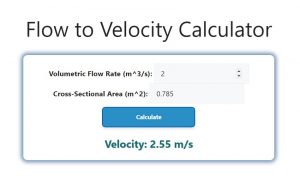About Flow to Velocity Calculator (Formula)
In fluid mechanics, understanding the relationship between flow and velocity is crucial for various applications, such as designing piping systems, optimizing water distribution, and analyzing fluid dynamics. The Flow to Velocity Calculator simplifies this process, allowing users to easily convert volumetric flow rate into velocity. By inputting the volumetric flow rate and the cross-sectional area of the flow path, you can obtain the fluid velocity, which is essential for engineers, architects, and anyone working with fluid systems.
Formula
The formula for calculating velocity from volumetric flow rate is:
Velocity (V) = Volumetric Flow Rate (Q) / Cross-Sectional Area (A)
Where:
- Velocity (V) is measured in meters per second (m/s).
- Volumetric Flow Rate (Q) is measured in cubic meters per second (m³/s).
- Cross-Sectional Area (A) is measured in square meters (m²).
How to Use
- Gather Required Information: You will need the volumetric flow rate of the fluid and the cross-sectional area of the flow channel or pipe.
- Measure Volumetric Flow Rate: This can be done using flow meters or calculated from other measurements, ensuring you have the value in cubic meters per second.
- Determine Cross-Sectional Area: Calculate the cross-sectional area of the flow channel. For circular pipes, use the formula: Area = π * (Diameter/2)². For rectangular channels, use: Area = Width * Height.
- Calculate Velocity: Enter the values for volumetric flow rate and cross-sectional area into the Flow to Velocity Calculator. The calculator will compute the fluid velocity based on the provided values.
Example
Let’s consider a circular pipe with a volumetric flow rate of 2 m³/s and a diameter of 1 meter. First, we calculate the cross-sectional area:
- Calculate Cross-Sectional Area:
Area = π * (1/2)² = π * 0.25 ≈ 0.785 m² - Calculate Velocity:
Velocity = Volumetric Flow Rate / Cross-Sectional Area
Velocity = 2 m³/s / 0.785 m² ≈ 2.55 m/s
In this example, the velocity of the fluid flowing through the pipe is approximately 2.55 meters per second.

FAQs
- What is the Flow to Velocity Calculator?
The Flow to Velocity Calculator is a tool that converts volumetric flow rate into fluid velocity based on the cross-sectional area. - Why is it important to calculate fluid velocity?
Calculating fluid velocity is essential for designing efficient fluid systems, predicting flow behavior, and ensuring proper operation of equipment. - What units are used for volumetric flow rate and velocity?
Volumetric flow rate is typically measured in cubic meters per second (m³/s), while velocity is measured in meters per second (m/s). - How do I measure the volumetric flow rate?
Volumetric flow rate can be measured using flow meters, or calculated based on the volume of fluid passing a point over time. - What is the cross-sectional area of a pipe?
The cross-sectional area of a pipe is the area of a slice taken perpendicular to the flow direction, crucial for calculating flow velocity. - Can I use this calculator for non-circular pipes?
Yes, the calculator can be used for any shape of the cross-section; just ensure the area is calculated correctly. - What factors can affect fluid velocity in a pipe?
Factors include pipe diameter, fluid viscosity, temperature, and any obstructions in the flow path. - What is the relationship between flow rate and velocity?
Flow rate is directly proportional to velocity; increasing the area or reducing the flow rate will decrease the velocity, and vice versa. - How do I convert from other flow units to cubic meters per second?
To convert flow units like liters per minute or gallons per minute to cubic meters per second, use conversion factors (1 L/min = 0.00001667 m³/s, 1 GPM = 0.00006309 m³/s). - Can this calculator be used for compressible fluids?
The calculator is primarily designed for incompressible fluids. For compressible flows, additional factors must be considered. - What are some applications of knowing fluid velocity?
Applications include hydraulic design, pipe sizing, pump selection, and predicting flow-induced forces. - Is the calculator applicable to open channel flows?
Yes, it can be used for open channel flows, but ensure the area is calculated based on the channel shape. - What is turbulent flow, and how does it affect velocity?
Turbulent flow is chaotic and can lead to higher energy losses compared to laminar flow, affecting velocity distribution. - How can I increase fluid velocity in a system?
You can increase fluid velocity by reducing the pipe diameter, increasing the flow rate, or decreasing the viscosity of the fluid. - What tools can help measure fluid velocity directly?
Flow meters, Pitot tubes, and anemometers are tools that can measure fluid velocity directly. - How does temperature affect fluid velocity?
Temperature changes can alter fluid viscosity, which in turn affects the flow rate and velocity. - What happens to fluid velocity in a converging pipe?
In a converging pipe, the fluid velocity increases as the cross-sectional area decreases, according to the principle of conservation of mass. - Can this calculator be used for gases?
Yes, the calculator can be adapted for gases, but consider compressibility effects if pressure changes significantly. - What is the significance of Reynolds number in relation to flow velocity?
The Reynolds number helps determine flow regime (laminar or turbulent) and can influence velocity profiles in pipes. - Where can I find more information on fluid dynamics?
Textbooks, academic journals, and online courses in fluid dynamics provide comprehensive information on the subject.
Conclusion
The Flow to Velocity Calculator is a valuable tool for engineers, designers, and anyone working with fluid systems. By using the simple formula and following the outlined steps, users can efficiently calculate fluid velocity from volumetric flow rate and cross-sectional area. Understanding fluid velocity is vital for optimizing system performance, enhancing safety, and improving energy efficiency in various applications. Whether you’re designing a new system or troubleshooting an existing one, accurate velocity calculations will help you make informed decisions.
